The Internet |
|
The Internet Part I
The device shown above is an abacus—the first "computer." An abacus takes no electricity, doesn't have to be booted up, requires no maintenance, and never crashes. The rings are flipped back and forth to represent the placement of numbers in a sequence. The abacus goes back hundreds of years and is still the preferred calculator for a few people in some countries. Today's electronic computers do the same thing—compute numbers; albeit a few billion times faster that an abacus. All of today's sophisticated software—word processors, games, editing systems, e-mail, and even the page you are viewing—can be reduced to a string of "0" and "1" numbers that a computer "computes." Even CD music and DVD movies consist of nothing more than combinations of these two numbers that are "computed" and then presented to our eyes and ears.
The World's First Computer— Although it is widely assumed that the world's first computer was the American Eniac, actually, Alan Turing, a British Postal employee developed the first computer in England during World War II. Turing's computer, the Colossus, contained 1,000 vacuum tubes and was a major (although until recently very secret) factor in the outcome of World War II. The Colossus was developed to decode critical German encrypted messages—messages that provided information so critical that some historians say that Turning's computer shortened the war by at least two years. One historian feels that one million lives may have been saved as a result of this invention. Although Turning was by some accounts the most important hero of the war, when it was discovered that he was gay, he was so persecuted—they thought he must be a security risk—that he ended up taking his own life.
The first computers filled entire rooms and required thousands of vacuum tubes. When the transistor was invented, the size of computers suddenly shrunk to a fraction of their original size—and this development set the stage for personal computers. The
personal computer was introduced in 1975. It was the
The Internet and the worldwide web are based on computers, of course. And, love them or hate them, some very basic things are important to understand. But, don't worry, we're not going into a long, technical explanation on how computers work—just what's necessary to understand and effectively get around the Internet. Although the terms Internet and the Worldwide Web are commonly used interchangeably, the worldwide web is actually only a part of the Internet. The latter includes Telnet, FTP (file transfer protocol), and other communication languages and approaches. However, when most people speak of the Internet today they are just focusing on the Worldwide Web—the part of the Internet that displays pages such as the one you are now viewing.
For the last two decades the number of U.S. homes connected to the Internet has been steadily growing—at least it was until April of 2001, when there was a slight decline from the peak of 70 million.
Even so, during this time, the largest
Internet service provider, America Online, announced that it had more
than 30-million subscribers, an all-time high.
The graph on the right illustrates the disparity between the races in home computer use and the Internet. Although some families may consider the Internet a luxury, savvy businesses now see it as a necessity in today's competitive business environment. The steady Internet growth also continued in schools. Virtually 100 percent of U.S. libraries have Internet connections. Computer classrooms, especially in grade schools and high schools, continue to expand. For example, the Henrico County Public Schools in Richmond, Va. recently placed an order for 23,000 Apple iBook laptops—enough for every teacher and student in its middle and high schools. The number of colleges and universities that require computers as part of their general curriculum continues to grow, and many college dormitories are now wired for high speed Internet access. Thousands of college classes depend on the Internet for reading materials and course research, and the number of complete courses on the Internet now totals several hundred thousand. Several institutions grant degrees solely on the basis of Internet coursework.
Millions of people no longer make out checks, address envelopes, and lick stamps to pay their bills—they simply do it all by mouse clicks. Some banks exist only on the Internet, which often means that the money they save on offices, facilities, etc., can not only be passed on to users in the form lower fees, but these institutions can also pay higher interest rates on accounts. After
the series of terrorist attacks in the United States that involved the
U.S. mail and biological materials such as anthrax, both Internet bill
paying and e-mail saw sudden spurts of growth.
Although Internet advertising trails the other media in total revenue, as you can see on the right, it is showing the most rapid growth. Advertising on the Internet has a controversial history. Many purists originally felt that the Internet should be free of advertising clutter and influence. (The same views were originally expressed against broadcast adverting.) Of course without advertising these media would not have developed as rapidly and as impressively as they did. Even with all of these developments, the Internet is still in its infancy. As bandwidth limitations and standards problems are resolved, many of the barriers to the more effective use of the Internet will be removed. A major problem for education is the inability to transmit full-screen, full-motion video—a problem that should soon be resolved. Compared to the traditional classroom, research has shown that students can do just as well, and sometimes better, by taking well-designed Internet courses. For students, Internet classes not only save time and money, but they can fit into difficult work schedules.
|
Speed Limits One of the major gripes about the Internet, of course, is how slow it can be. So, first we'll examine the things that limit speed and give you some pointers on how you can speed things up—especially when "surfing the net" from home.
The speed of your computer's CPU (central processing unit—a computer chip that's the heart of your computer) will to a large extent determine the speed of software operations.
Every six months or so the CPU chipmakers are able to develop a faster CPU. This is one of the reasons computers quickly become obsolete. Part of a motherboard (the main circuit board area of the computer) is shown above. Although there is a definite element of ego behind having the "fastest computer on the block," there is also a practical element. As computer programs become more complex, computer resources—especially speed—must also advance, simply to keep pace.
CPU speed is only one of several factors that determine how fast things will happen on your computer. The amount of memory your computer has is also important. Most computers today have between 128 and 256 megs (megabits) of RAM (random-access memory). When your computer boots up (starts), needed programs are loaded into RAM, where information can be quickly accessed. RAM is volatile memory because all of the information in RAM disappears when the power to your computer shuts off. This, of course, includes whatever data that you may have been reading or working that wasn't saved on a hard or floppy disk. The hard drive in your computer represents nonvolatile memory, or information that is recorded on a medium—in this case a hard drive—that stays there once the power to your computer is shut off. Thus, any information you want available the next time you boot up your computer must be saved on a disk drive. The speed of RAM (how quickly it can absorb and transmit information) is also important to computer speed. RAM speed is measured in nanoseconds (ns), or billionths of a second. In terms of speed, the smaller the number, the better.
A typical computer chip is shown on the right. As computer programs get bigger and more complex, there is also a need to add more computer RAM so that things won't slow down.
Hard disks were invented in the 1950s. The first ones used disks (platters) 20 inches in diameter, and they held just a few megabytes of information. In the past 50-plus years hard drives have shrunk to a fraction of their original size, while their storage capacity has increased thousands of times. At the same time the overall cost has gone down. (This has been one of the few things in life where you have been able to get more for less money on almost a monthly basis.)
A
cutaway view of a
The read-write heads move very fast; they can flip back and forth over the total surface of the disk at least 50 times a second, while, at the same time, gathering or recording data. The hard drive shown above has four platters and requires several read-write heads for the top and bottom surfaces of each of the platters. As the platter spins and the read-write heads swing back and forth over the disk's surface digital data is magnetically transferred to or read from invisible microscopic tracks on the disk's surface.
Note that in the drawing on the left a sector or block of data is one segment of a track. Each sector contains a fixed number of bytes of information—generally 256 or 512 bytes. (These tracks are actually microscopic, but we've enlarged them so they could be seen in the drawing.) For any number of reasons, including an unexpected loss of power, you should regularly save the information you are working on to the nonvolatile memory of your computer's hard drive. (Of course, most of us learn this the hard way when we lose an hour's work!) Hard drives also have speed considerations. The speed at which data can be written to and read from a hard drive represents a major limiting factor in computer speed. If you see the specifications on two hard drives, for example—one of which reads and writes information at 12ms (millionths of a second) and the other one at 8ms—you know that the smaller number is better because it represents less time. When billions of bits of data are regularly being written to and read from a hard drive, this becomes very important to computer speed. The platters or disks rotate at a constant speed, which, depending on the design, may range from 3,600 to 7,200 rpm (revolutions per minute) The soft "whining sound you hear from a computer when it's running is probably the hard drive spinning. Although hard drives can have life spans of many thousands of hours, all of them at some time will fail (crash). Like earthquakes in California, it isn't a matter of if, it's a matter of when. This can be caused by a strong jolt that crashes a head into the surface of a platter, or just by a part eventually wearing out. When a hard drive fails—and that's generally without any notice that a problem is even looming—you lose all of the data on the hard drive, which generally represents all of your data and programs. However, since computer models and designs tend to be obsolete in a few years, a hard drive might easily outlast the practical life of the computer. But, of course, you can't count on that! Therefore, you need to keep the CDs of all your original programs along with their original installation keys so the programs can be reinstalled. Even if your hard drive doesn't crash, you sometimes have to reinstall programs when information gets corrupted on your hard drive by a virus or by a scrambled write-to-disk operation. You also need to keep at least one good copy of all of your
Keep in mind that program and data information that won't fit into RAM when the computer boots up must be read from the hard drive, which is a slower process than using RAM for the same purpose. Thus, the more RAM the better. In the next section we'll look at how data gets from your computer to the Internet and back. You might be amazed that the process works at all! |
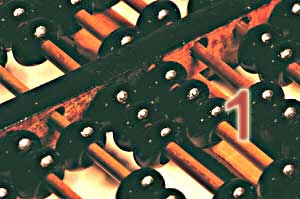
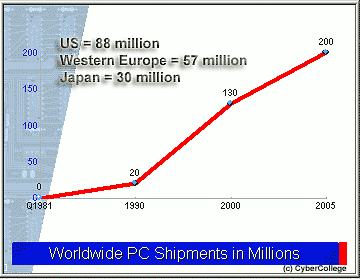 Altair,
the device that Bill Gates of Microsoft, now reputed to be the world's
richest man, took an immediate interest in. And the rest, as they say,
is history. That history is graphically shown on the right.
Altair,
the device that Bill Gates of Microsoft, now reputed to be the world's
richest man, took an immediate interest in. And the rest, as they say,
is history. That history is graphically shown on the right.
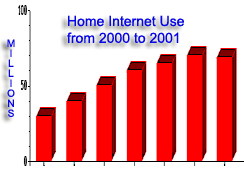 The
3% decline (see graph) can be attributed to four things. During the
first part of 2001, a number of free Internet services went bankrupt
and thousands of people who were using these services dropped out. Some
free services started charging fees based on usage time. Many people
who signed up for high-speed DSL (digital subscriber lines) were disappointed
when providers couldn't deliver promised services. And, finally, the
economic downturn during the first part of 2001 in the United States
resulted in belt-tightening by many people, and many non-necessities
were eliminated from budgets.
The
3% decline (see graph) can be attributed to four things. During the
first part of 2001, a number of free Internet services went bankrupt
and thousands of people who were using these services dropped out. Some
free services started charging fees based on usage time. Many people
who signed up for high-speed DSL (digital subscriber lines) were disappointed
when providers couldn't deliver promised services. And, finally, the
economic downturn during the first part of 2001 in the United States
resulted in belt-tightening by many people, and many non-necessities
were eliminated from budgets.

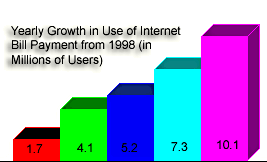 Another
indication of the rapid growth of computer use has been the
increase in bill paying over the Internet.
Another
indication of the rapid growth of computer use has been the
increase in bill paying over the Internet.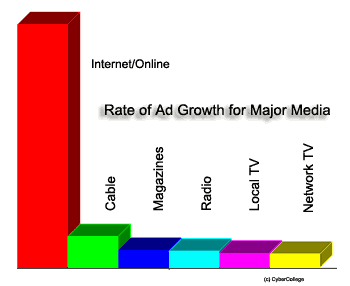
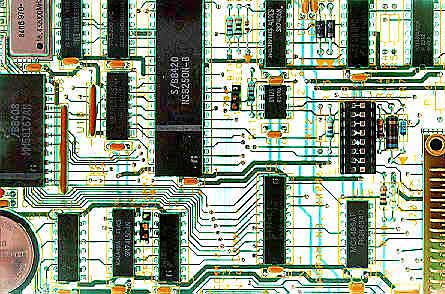 Most
computers today have CPU speeds of between 300 and MHz (megahertz, or
millions of operations per second). The latest computer CPUs operate
at more than 1 GHz (gigahertz, or billion operations per second).
Most
computers today have CPU speeds of between 300 and MHz (megahertz, or
millions of operations per second). The latest computer CPUs operate
at more than 1 GHz (gigahertz, or billion operations per second).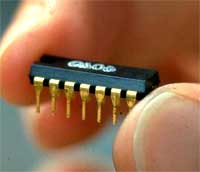
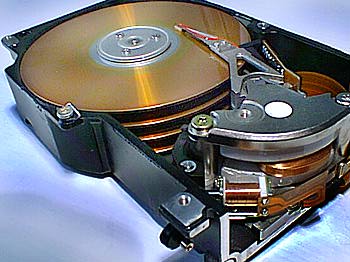 hard
drive is shown here. The read-write head (the silver arm you see suspended
over the top of the rust-colored platter), rides on an ultra layer of
air as the platter (disk) spins. This separation is critical, because
if one of these heads comes in direct contact with highly-polished surface
of the a platter, it will scratch it and possibly damage the head. In
either case, major problems result.
hard
drive is shown here. The read-write head (the silver arm you see suspended
over the top of the rust-colored platter), rides on an ultra layer of
air as the platter (disk) spins. This separation is critical, because
if one of these heads comes in direct contact with highly-polished surface
of the a platter, it will scratch it and possibly damage the head. In
either case, major problems result.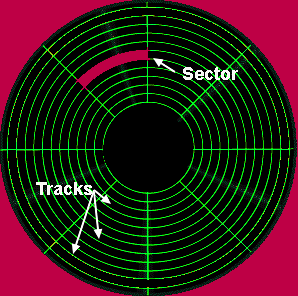 These magnetic traces are organized into tracks
and
sectors.
These magnetic traces are organized into tracks
and
sectors. important data on a medium such as a floppy disk or a recordable CD. This is called backing up your data. There seems to be a "Murpy's Law" involved here: it's only the original data that you failed to back up that will unexpectedly disappear or get destroyed!
important data on a medium such as a floppy disk or a recordable CD. This is called backing up your data. There seems to be a "Murpy's Law" involved here: it's only the original data that you failed to back up that will unexpectedly disappear or get destroyed!